Field Treatment of Storage Sludge and Stability Analysis of Overlying Municipal Waste Landfilling
Abstract
:1. Introduction
2. Raw Storage Sludge Characterization
2.1. Site Description
2.2. Field Sampling
2.3. Physical Properties
3. Stratified Treatment of Storage Sludge
4. Analysis of the Solidified Sludge
4.1. Field Sampling
4.2. Physical Properties
4.2.1. Water Content
4.2.2. Strength Properties
5. Stability Analysis
6. Conclusions
- (1)
- The raw storage sludge in the sludge pond at the Qizishan landfill is stratified into layers, which are mud–water mixing sludge, fluid sludge, and fluid–plastic sludge layers. As the buried depth increases, the water content of the sludge decreases and the undrained shear strength increases. The water content ranges from 172% to 7270%, with an average of about 1397%, and the strength remains at a low level overall, which ranges from 0.20 kPa to 14.90 kPa.
- (2)
- The ex situ dehydration of the mud–water mixing sludge uses the geotextile tubes, in which the flocculation is conducted, and is followed by the high-pressure dehydration. The fluid and fluid–plastic sludges are solidified through in situ stirring and high-pressure churning, respectively. The stratified treatment results in a significant decrease from 1398% to 88% in the average water content and an increase to 23.52 kPa, on average, in the cohesion.
- (3)
- The strength of the deep solidified sludge varies more dramatically with the water content than that of the shallow solidified sludge. The high content of clay particles, low amount of solidification products, and high water content together result in the strength of the deep solidified sludge having a higher sensitivity to the water content than that of the shallow solidified sludge.
- (4)
- The landfill body is prone to sliding along the inside of the sludge pond when the waste is piled directly above the raw sludge pond. The stability analysis of the waste body on the solidified sludge pond shows that the potential sliding surface occurs in the fresh waste body rather than in the solidified sludge pond, and the Fs is increased from 0.934 to 1.464, which verifies the validity of the presented sludge pond treatment.
Author Contributions
Funding
Conflicts of Interest
References
- Demirbas, A.; Edris, G.; Alalayah, W.M. Sludge production from municipal wastewater treatment in sewage treatment plant. Energy Sources Part A Recover. Util. Environ. Eff. 2017, 39, 999–1006. [Google Scholar] [CrossRef]
- Liu, T.; He, J.; Cui, C.; Tang, J.; Wang, M. Effect of woody and non-woody bulking agents on biodrying of long-term storage sludge. Desalination Water Treat. 2018, 129, 53–61. [Google Scholar] [CrossRef] [Green Version]
- Zhan, T.L.; Zhan, X.; Lin, W.; Luo, X.; Chen, Y. Field and laboratory investigation on geotechnical properties of sewage sludge disposed in a pit at Changan landfill, Chengdu, China. Eng. Geol. 2014, 170, 24–32. [Google Scholar] [CrossRef]
- Fytili, D.; Zabaniotou, A. Utilization of sewage sludge in EU application of old and new methods—A review. Renew. Sustain. Energy Rev. 2008, 12, 116–140. [Google Scholar] [CrossRef]
- O’Kelly, B.C. Geotechnics of municipal sludges and residues for landfilling. Geotech. Res. 2016, 3, 148–179. [Google Scholar] [CrossRef] [Green Version]
- Zhao, L.; Gu, W.-M.; He, P.-J.; Shao, L.-M. Effect of air-flow rate and turning frequency on bio-drying of dewatered sludge. Water Res. 2010, 44, 6144–6152. [Google Scholar] [CrossRef] [PubMed]
- Lin, W.A.; Zhan, X.J.; Zhan, L.T.; Chen, Y.M.; Jin, Y.W.; Jiang, J.N. Effect of FeCl3- conditioning on consolidation property of sew-age sludge and vacuum preloading test with integrated PVDs at the Changan landfill, China. Geotext. Geomembr. 2014, 42, 181–190. [Google Scholar] [CrossRef]
- Koda, E.; Szymanski, A.; Wolski, W. Field and laboratory experience with the use of strip drains in organic soils. Can. Geotech. J. 1993, 30, 308–318. [Google Scholar] [CrossRef]
- Zhan, X.J. Study on consolidation mechanism of sewage sludge under combined effect of chemical conditioning and vac-uum preloading and its application. Ph.D. Thesis, Zhejiang University, Hangzhou, China, 2016. (In Chinese). [Google Scholar]
- Chu, J.; Goi, M.H.; Lim, T.T. Consolidation of cement-treated sewage sludge using vertical drains. Can. Geotech. J. 2005, 42, 528–540. [Google Scholar] [CrossRef]
- Guezennec, A.G.; Michel, C.; Bru, K.; Touze, S.; Desroche, N.; Mnif, I.; Motelica-Heino, M. Transfer and degradation of poly-acrylamide-based flocculants in hydrosystems: A review. Environ. Sci. Pollut. Res. 2015, 22, 6390–6406. [Google Scholar] [CrossRef] [Green Version]
- Wu, Y.; Lin, Z.; Kong, G.; Hu, T. Treatment of municipal sludge by Fenton oxidation combined vacuum preloading. Environ. Sci. Pollut. Res. 2018, 25, 15990–15997. [Google Scholar] [CrossRef] [PubMed]
- Wang, Y.; Zhou, Y.; Feng, D.; Wu, C.; Wang, X.; Min, F. Effects of Chemical Conditioners on Deep Dewatering of Urban Dewatered Sewage Sludge in the Temporary Sludge Lagoon. J. Environ. Eng. 2019, 145, 04019063. [Google Scholar] [CrossRef]
- Benoit, J.; Eighmy, T.T.; Crannell, B.S. Landfilling Ash/Sludge Mixtures. J. Geotech. Geoenvironmental Eng. 1999, 125, 877–888. [Google Scholar] [CrossRef]
- Lim, T.; Chu, J.; Goi, M. Effects of cement on redistribution of trace metals and dissolution of organics in sewage sludge and its inorganic waste-amended products. Waste Manag. 2006, 26, 1294–1304. [Google Scholar] [CrossRef] [PubMed]
- Disfani, M.M.; Arulrajah, A.; Maghoolpilehrood, F.; Bo, M.W.; Narsilio, G.A. Geotechnical characteristics of stabilised aged bio-solids. Environ. Geotech. 2015, 2, 269–279. [Google Scholar] [CrossRef]
- Kayser, C.; Larkin, T.; Singhal, N. Amendment of biosolids with waste materials and lime: Effect on geoenvironmental properties and leachate production. Waste Manag. 2015, 46, 165–175. [Google Scholar] [CrossRef] [PubMed]
- Xin, D.; Chai, X.; Zhao, W. Hybrid cement-assisted dewatering, solidification and stabilization of sewage sludge with high organic content. J. Mater. Cycles Waste Manag. 2014, 18, 356–365. [Google Scholar] [CrossRef]
- Legiec, I.A.; Jensen, R.H.; Little, N.K.; Bryan, R.E.; McDevitt, M.F.; Campbell, B.D. In situ solidification of an industrial sludge la-goon: Laboratory studies and field activities. Journal of Environmental Science and Health. Part A Environ. Sci. Eng. Toxicol. 1996, 31, 2777–2799. [Google Scholar]
- Zhan, L.T.; Luo, X.Y.; Guan, R.Q.; Zen, X.; Lan, J.W.; Chen, Y.M.; Lin, W.A. Failure mechanism of sludge pit and downstream waste slope of a MSW landfill. Chin. J. Geotech. Eng. 2013, 35, 1189–1196. (In Chinese) [Google Scholar]
- Lo, I.M.; Zhou, W.W.; Lee, K.M. Geotechnical characterization of dewatered sewage sludge for landfill disposal. Can. Geotech. J. 2002, 39, 1139–1149. [Google Scholar] [CrossRef]
- Cao, Y.H.; Yin, C.Q. Engineering Properties and Landfill of Stabilized Sludge. In Proceedings of the International Conference on Sustainable Energy and Environmental Engineering (ICSEEE 2012), Guangzhou, China, 29–30 December 2012; 29–30; Volume 295–298, pp. 1751–1754. [Google Scholar]
- ASTM D2974-20 Standard Test Methods for Determining the Water (Moisture) Content, Ash Content, and Organic Ma-terial of Peat and Other Organic Soils; ASTM International: West Conshohocken, PA, USA, 2020; 5p.
- ASTM D3441–16 Standard Test Method for Mechanical Cone Penetration Testing of Soils; ASTM International: West Conshohocken, PA, USA, 2016; 8p.
- ASTM D2573/D2573M−18 Standard Test Method for Field Vane Shear Test in Saturated Fine-Grained Soils; ASTM International: West Conshohocken, PA, USA, 2018; 8p.
- Pavlović, M.N.; Cotsovos, D.M.; Dedić, M.M.; Savidu, A. Reinforced jet-grouted piles. Part 1: Analysis and design. Proc. Inst. Civ. Eng. -Struct. Build. 2010, 163, 299–308. [Google Scholar] [CrossRef]
- Zouboulis, A.I.; Tzoupanos, N.D. Polyaluminium silicate chloride-A systematic study for the preparation and applica-tion of an efficient coagulant for water or wastewater treatment. J. Hazard. Mater. 2009, 162, 1379–1389. [Google Scholar] [CrossRef] [PubMed]
- Bharti, S.; Mishra, S.; Sen, G. Ceric ion initiated synthesis of polyacrylamide grafted oatmeal: Its application as flocculant for wastewater treatment. Carbohydr. Polym. 2013, 93, 528–536. [Google Scholar] [CrossRef]
- Muthukumaran, A.E.; Ilamparuthi, K. Laboratory studies on geotextile filters as used in geotextile tube dewatering. Geotext. Geomembr. 2006, 24, 210–219. [Google Scholar] [CrossRef]
- AASHTO T236-08 Standard Method of Test for Direct Shear Test of Soils under Consolidated Drained Conditions; AASHTO: Washington, DC, USA, 2018; 9p.
- Hu, Z.F.; Fu, Y.R. Experimental Study of the Shear Strength of Soft Soil with Different Initial Water Content. Shanghai Geol. 2000, 77, 38–42. [Google Scholar]
- Ma, P.C.; Ke, H.; Lan, J.W.; Chen, Y.M.; He, H.J. Field measurement of pore pressures and liquid-gas distribution using drilling and ERT in a high food waste content MSW landfill in Guangzhou, China. Eng. Geol. 2019, 250, 21–33. [Google Scholar] [CrossRef]
- CJJ 176-2012. Technical Code for Geotechnical Engineering of Municipal Solid Waste Sanitary Landfill; China Building Industry Press: Beijing, China, 2012. (In Chinese) [Google Scholar]
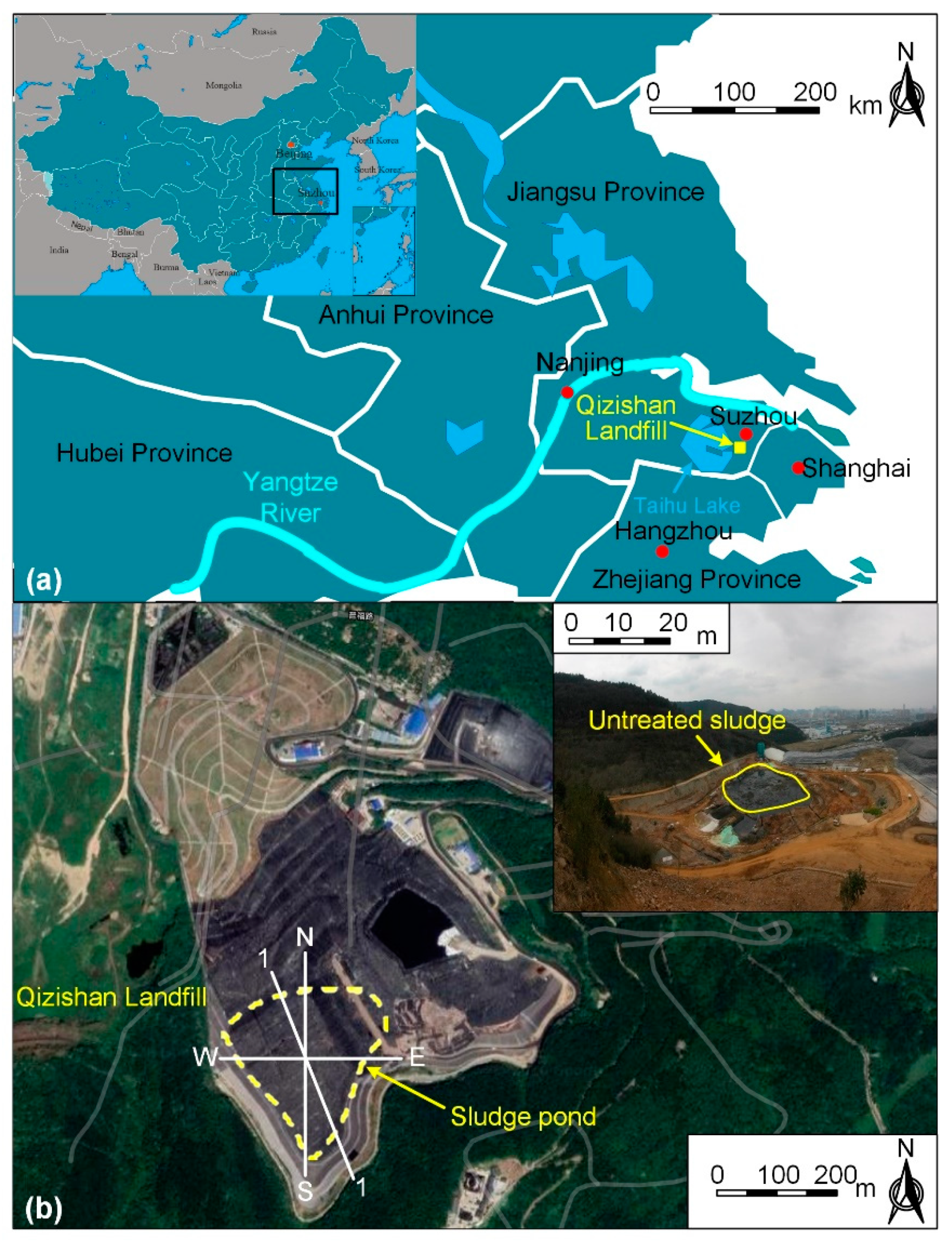

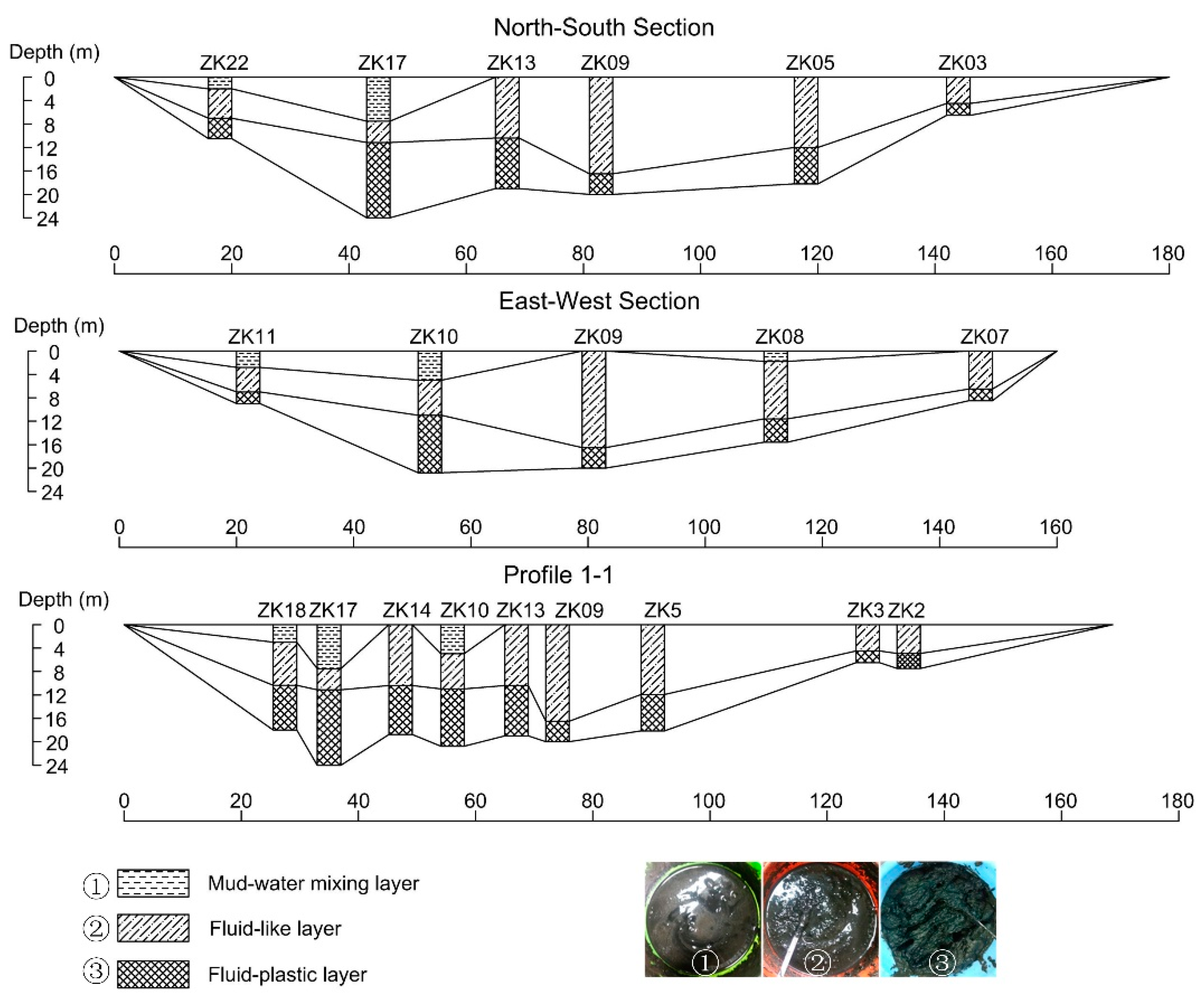

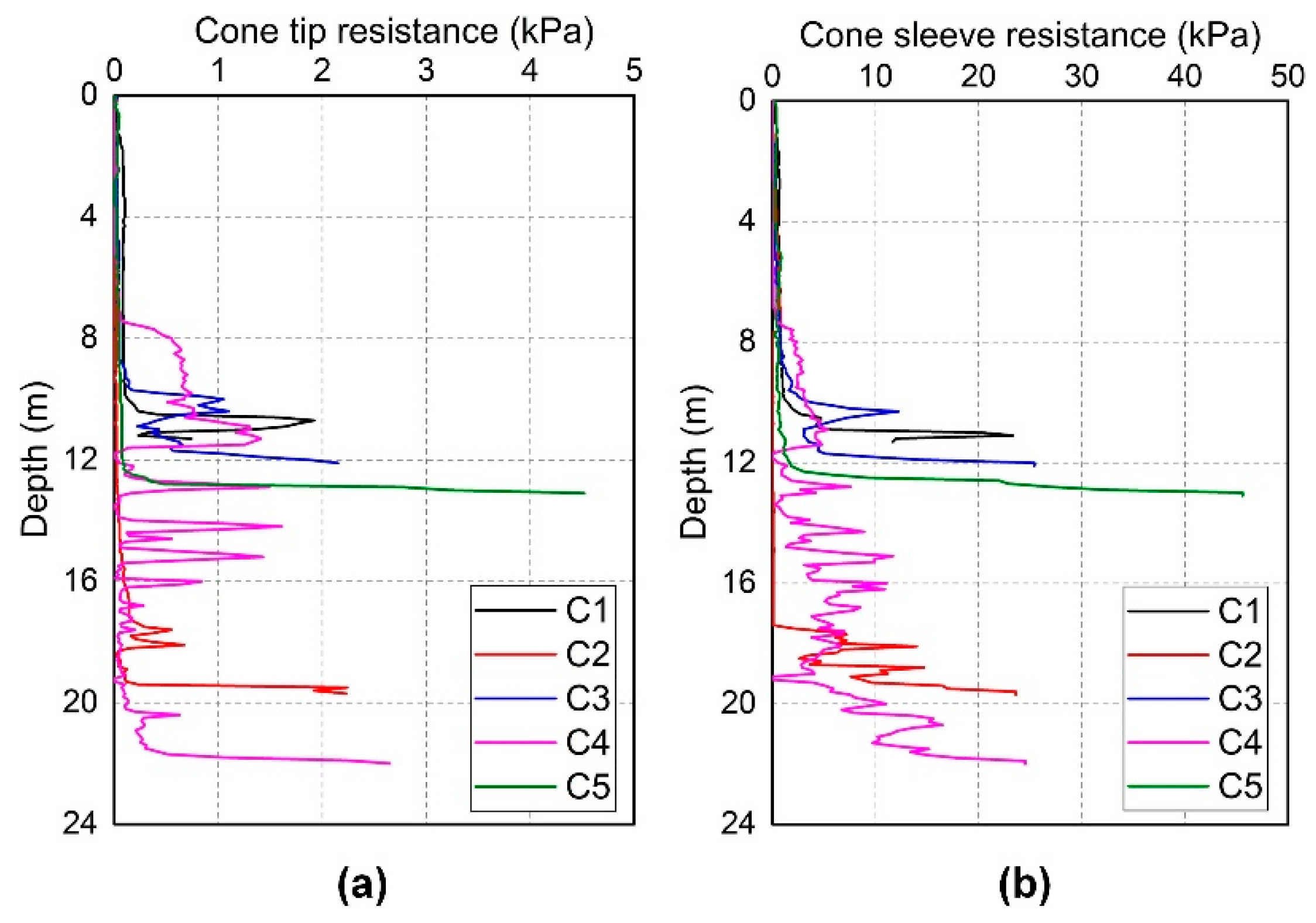

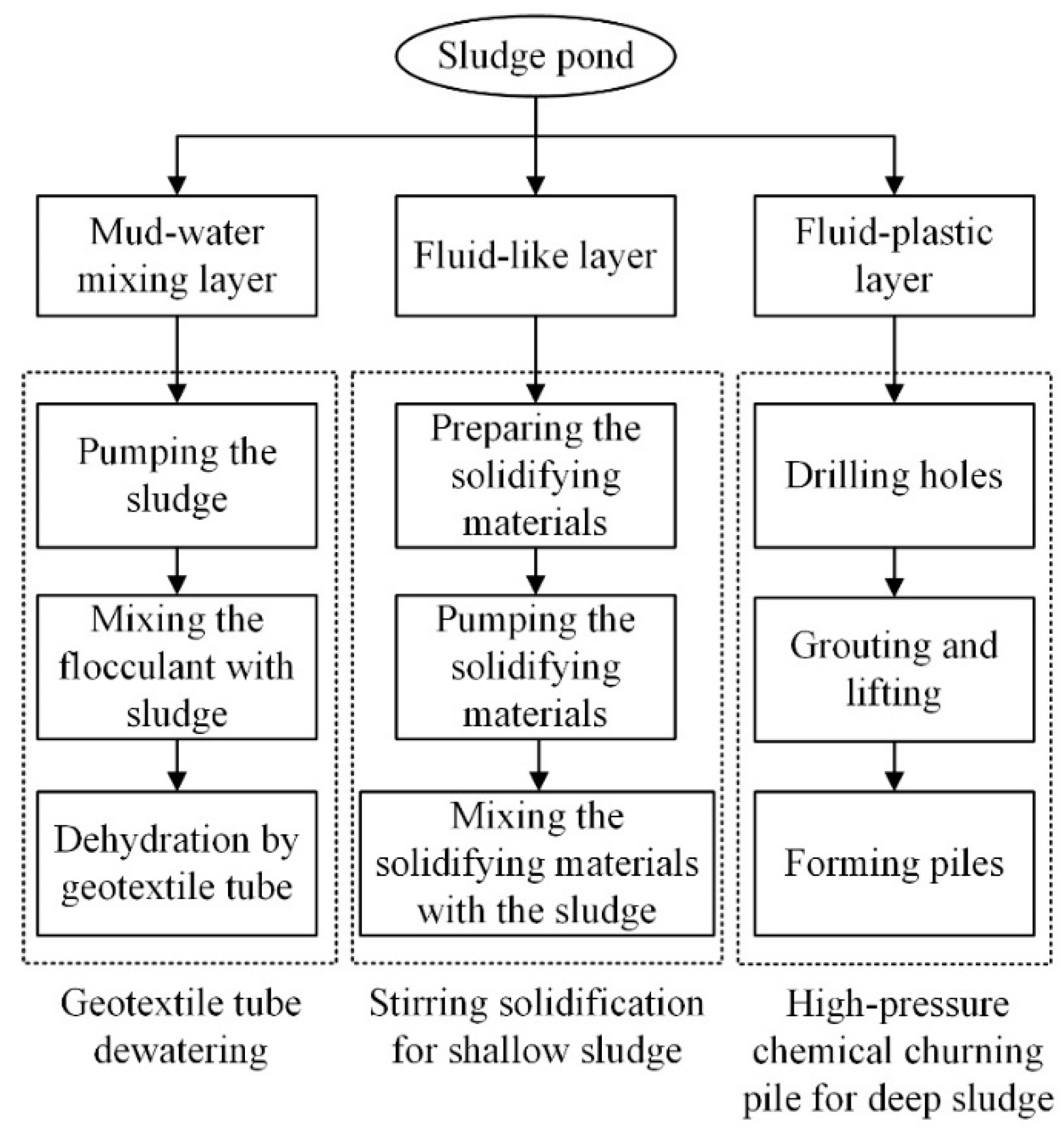
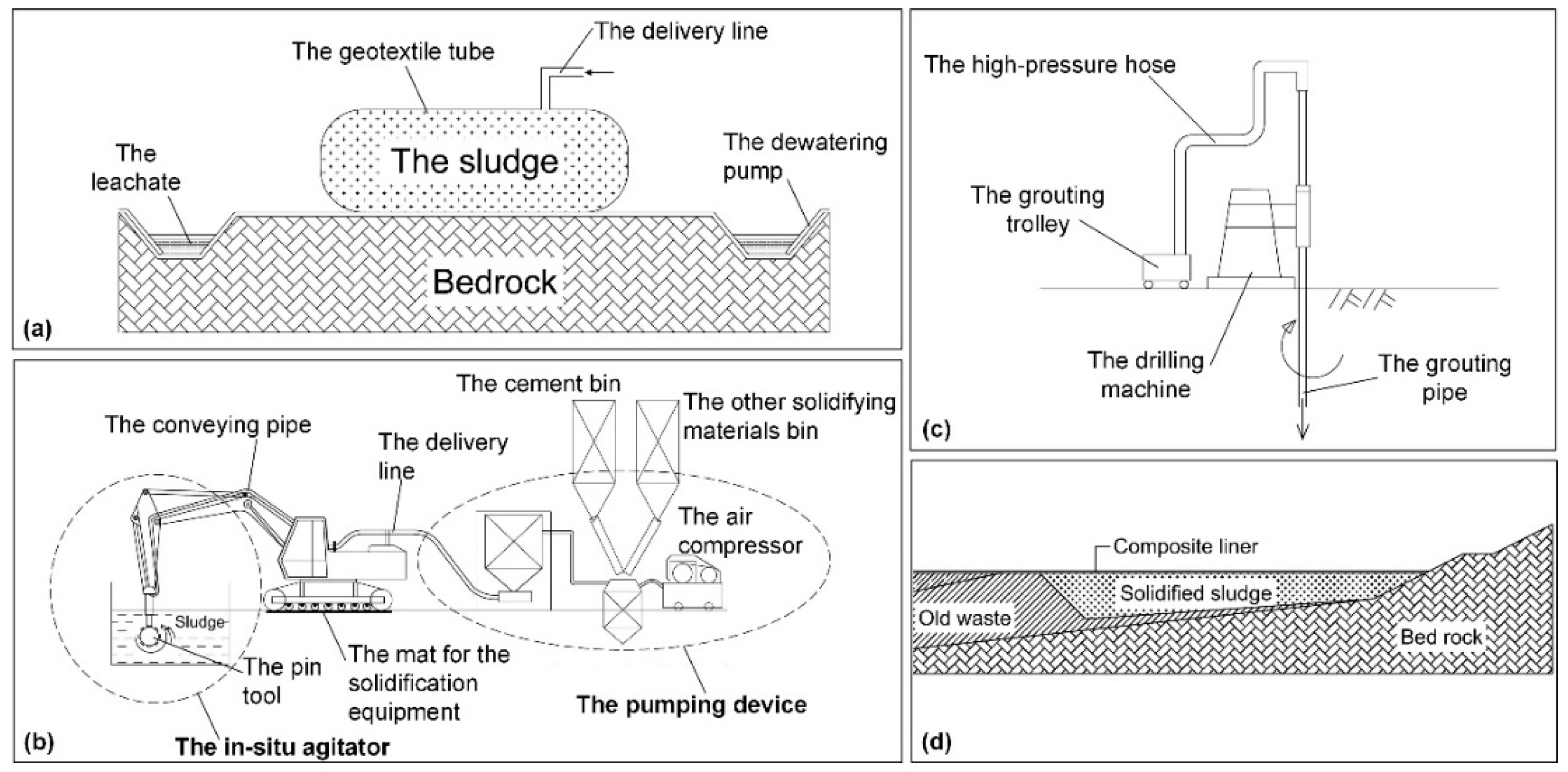
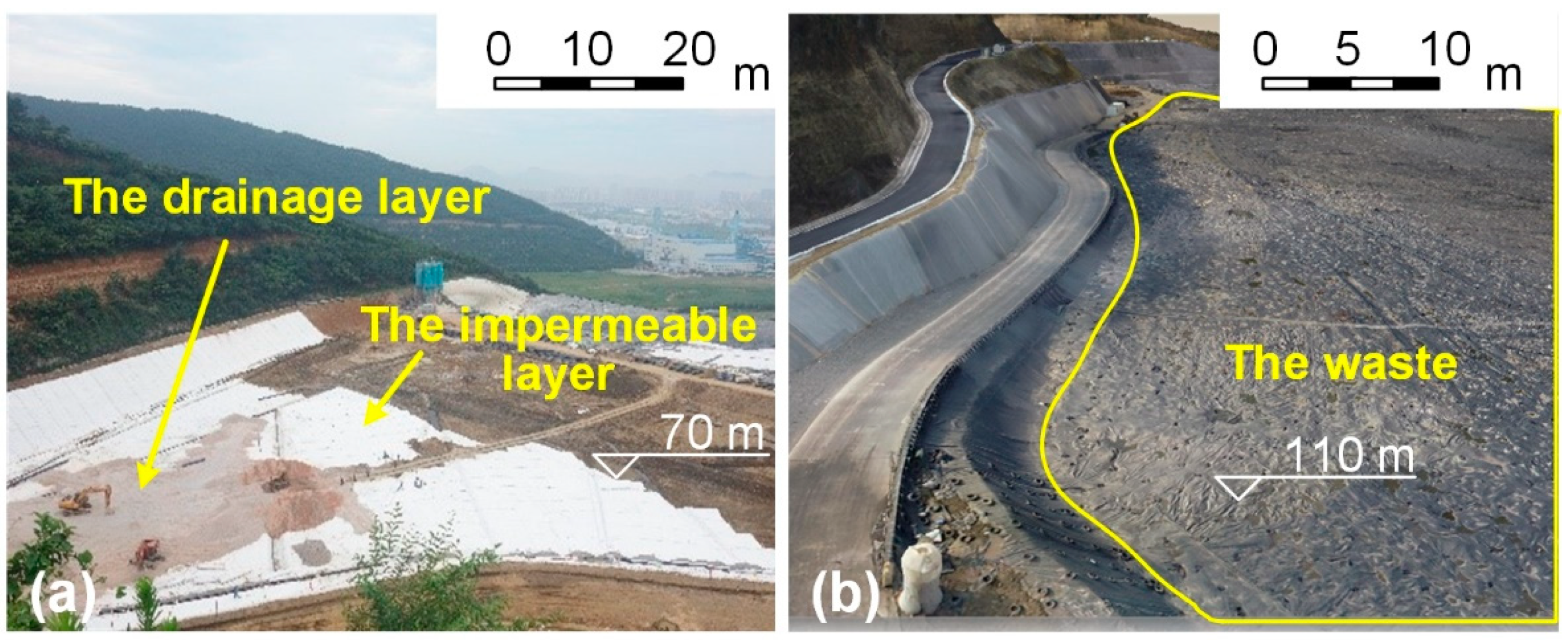
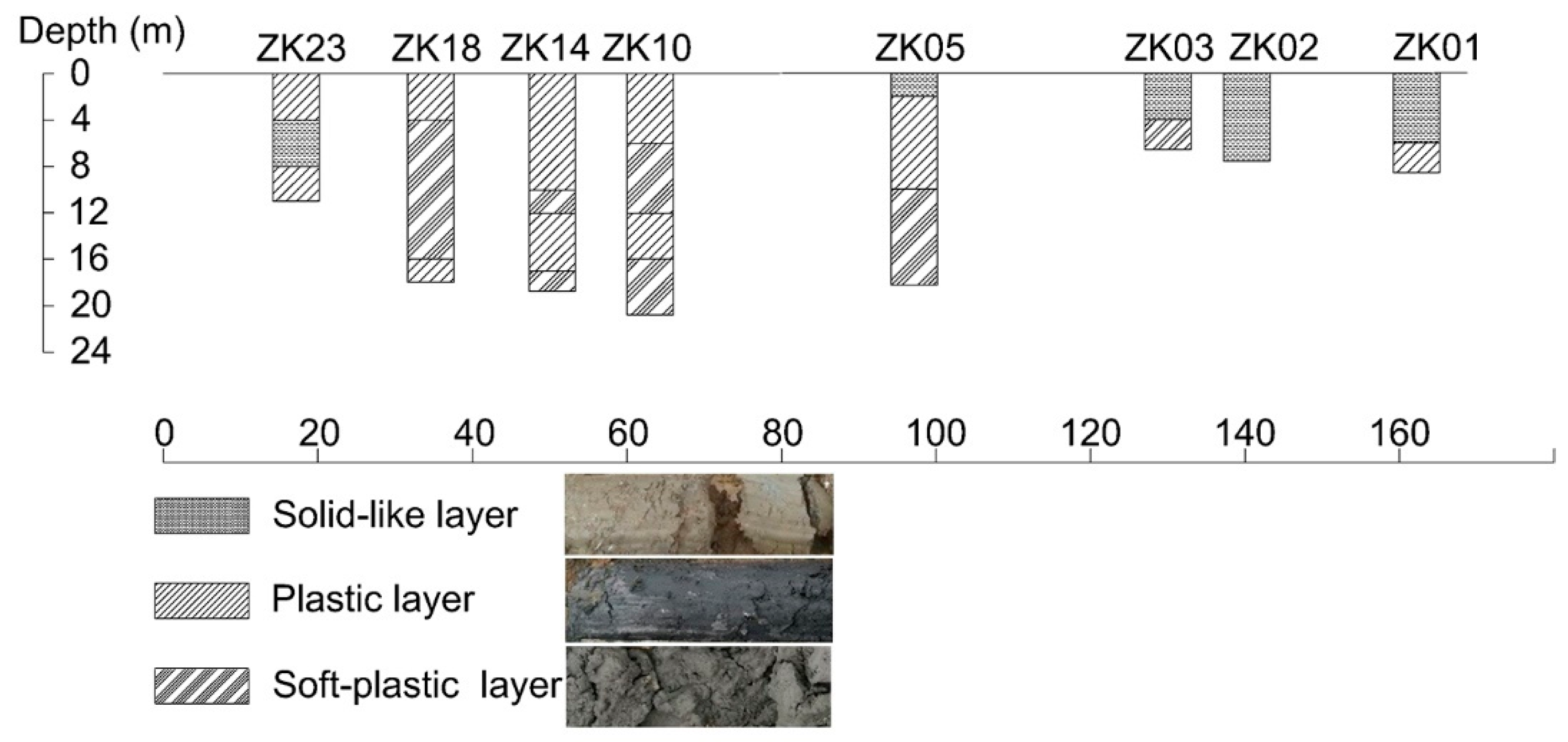
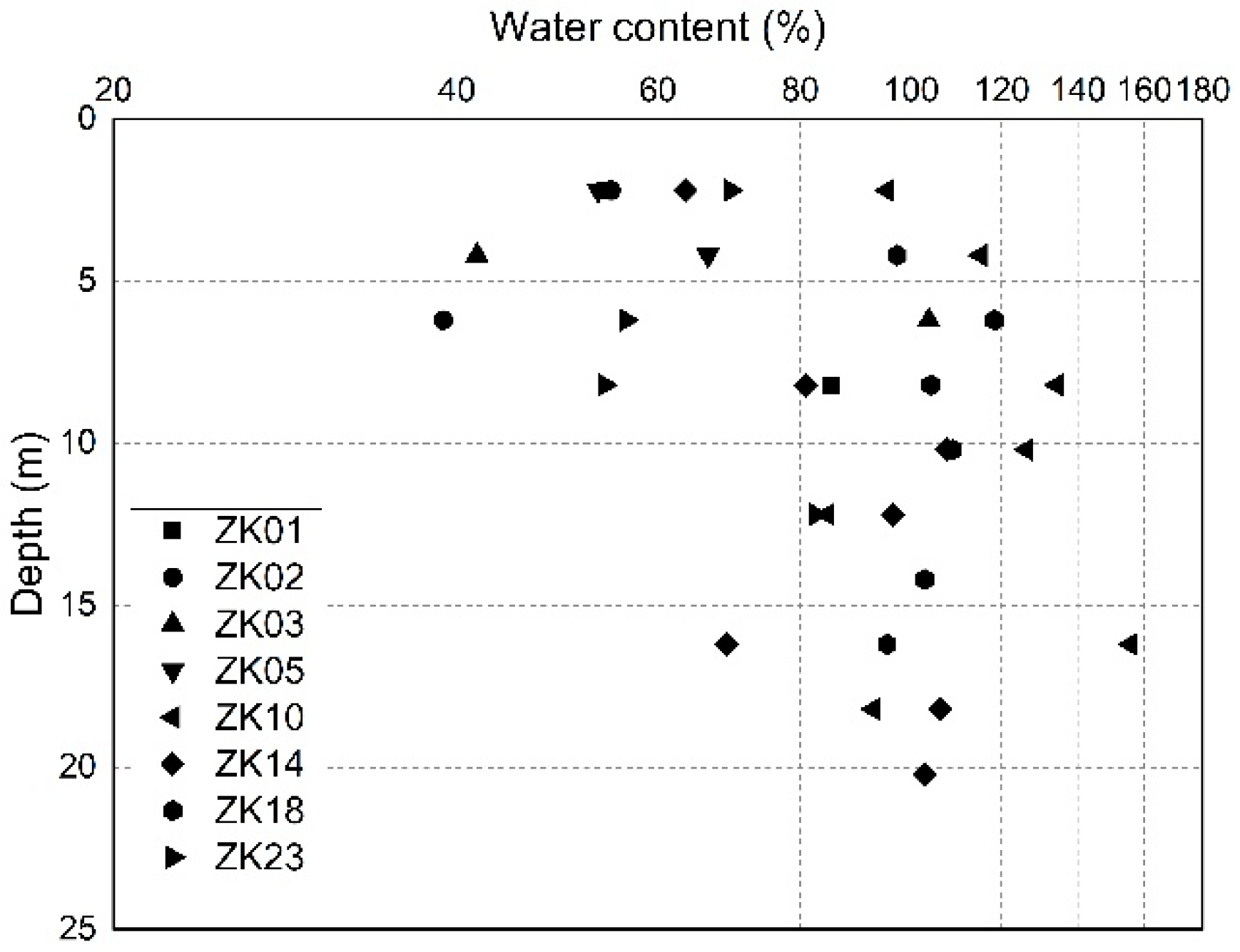
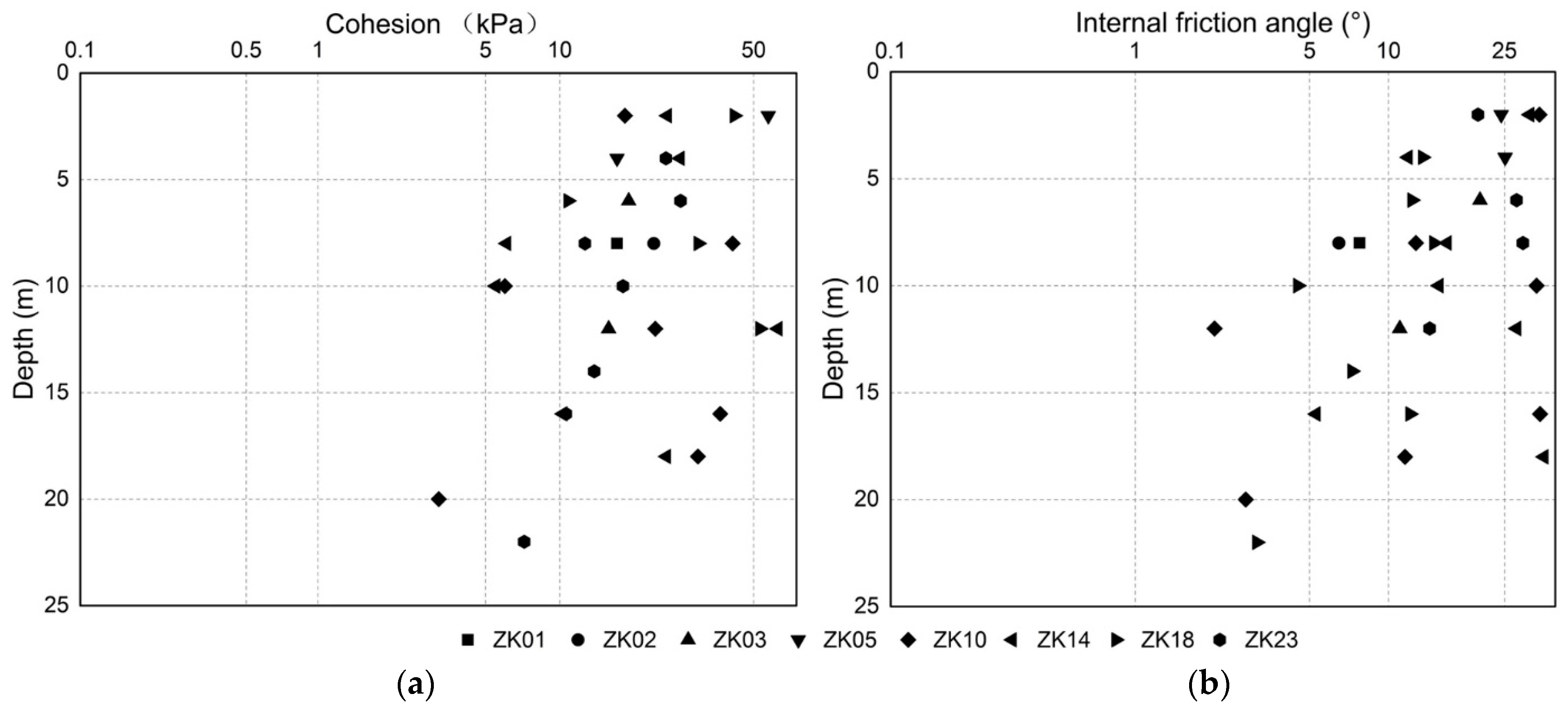
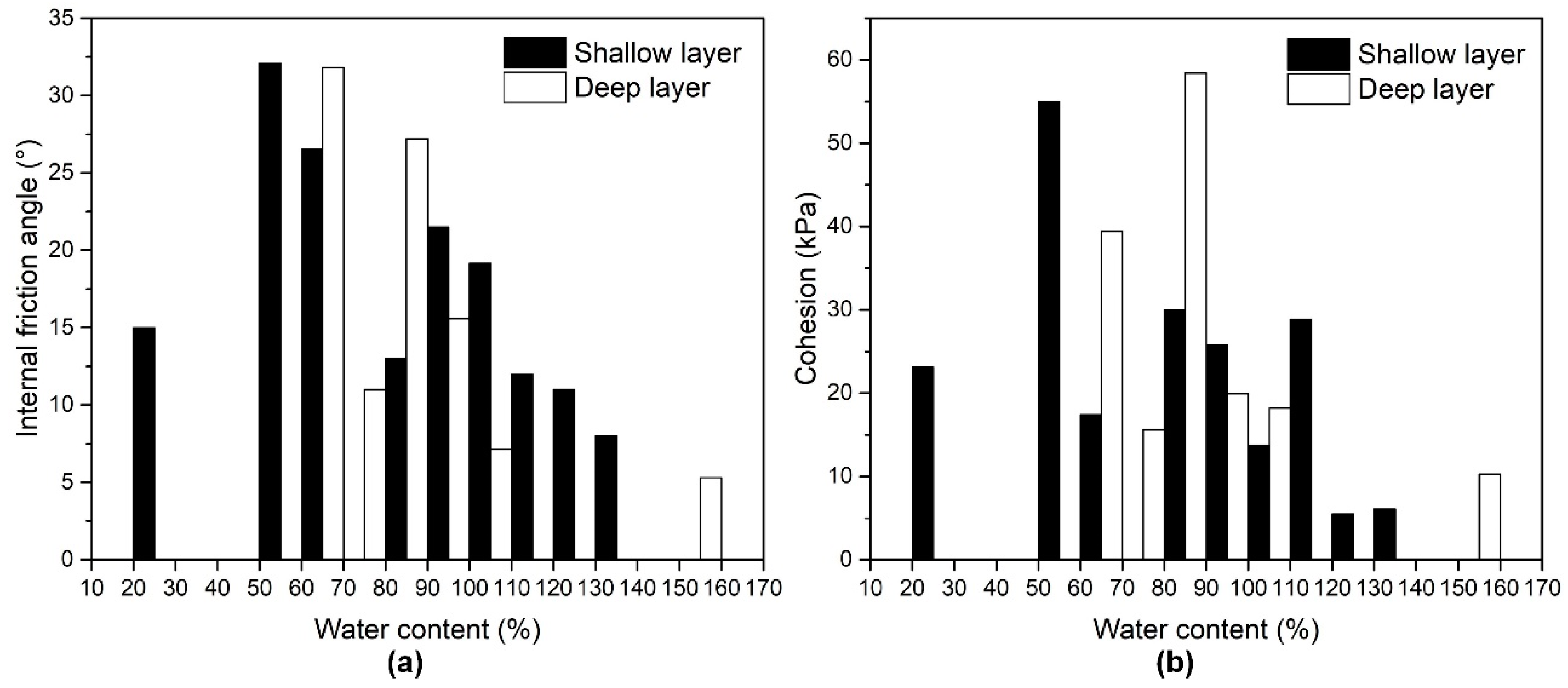

| Components | Portland Cement | Fly Ash | Quick Lime | Ferrous Sulfate | Aluminum Sulfate | Calcium Chloride |
|---|---|---|---|---|---|---|
| Weight percentage (%) | 33.2 | 15.4 | 23.7 | 18.1 | 7.2 | 2.4 |
| Material | Unit Weight (kN/m3) | Cohesion (kPa) | Internal Friction Angle (°) |
|---|---|---|---|
| Shallow waste | 11.7 | 20.8 | 21.4 |
| Old waste | 12 | 29.5 | 0 |
| Fresh waste | 10 | 21.6 | 9.6 |
| Waste dam | 20 | 200 | 50 |
| Mud-water mixing sludge | 10 | 0 | 0 |
| Fluid sludge | 10.02 | 4 | 0 |
| Fluid-plastic sludge | 10.08 | 10 | 0 |
| Composite liner | 18 | 0 | 20 |
Publisher’s Note: MDPI stays neutral with regard to jurisdictional claims in published maps and institutional affiliations. |
© 2021 by the authors. Licensee MDPI, Basel, Switzerland. This article is an open access article distributed under the terms and conditions of the Creative Commons Attribution (CC BY) license (https://creativecommons.org/licenses/by/4.0/).
Share and Cite
An, K.; Zhuang, D.; Lin, W.; Argilaga, A.; Chen, Y.; Zhan, L. Field Treatment of Storage Sludge and Stability Analysis of Overlying Municipal Waste Landfilling. Appl. Sci. 2021, 11, 12102. https://doi.org/10.3390/app112412102
An K, Zhuang D, Lin W, Argilaga A, Chen Y, Zhan L. Field Treatment of Storage Sludge and Stability Analysis of Overlying Municipal Waste Landfilling. Applied Sciences. 2021; 11(24):12102. https://doi.org/10.3390/app112412102
Chicago/Turabian StyleAn, Kaixi, Duanyang Zhuang, Weian Lin, Albert Argilaga, Yunmin Chen, and Liangtong Zhan. 2021. "Field Treatment of Storage Sludge and Stability Analysis of Overlying Municipal Waste Landfilling" Applied Sciences 11, no. 24: 12102. https://doi.org/10.3390/app112412102
APA StyleAn, K., Zhuang, D., Lin, W., Argilaga, A., Chen, Y., & Zhan, L. (2021). Field Treatment of Storage Sludge and Stability Analysis of Overlying Municipal Waste Landfilling. Applied Sciences, 11(24), 12102. https://doi.org/10.3390/app112412102







